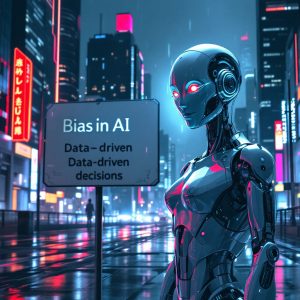Artificial Intelligence (AI) is often hailed as the great impartial mind of our digital age. It doesn’t eat, doesn’t sleep, doesn’t gossip by the water cooler, and—best of all—it doesn’t have prejudices. Right?
Well, not exactly.
Turns out, AI is just as susceptible to bias as the humans who build and train it—sometimes even more so. In fact, when it comes to decision-making in sectors like hiring, policing, banking, and beyond, AI can amplify existing biases at lightning speed, giving them a shiny new coat of algorithmic legitimacy.
In this blog post, we’ll explore: What AI bias is (explained without a PhD required); Real-world examples that show how AI bias can go seriously sideways; The legal implications under German and EU law; How lawmakers are scrambling to keep up with our robo-friends
Ready to decode the dark side of digital decision-making? Let’s go.
What Is Bias in AI (and Why Should We Care)?
AI bias (also known as algorithmic bias) occurs when an AI system systematically produces skewed results that disadvantage certain individuals or groups. It doesn’t mean the machine is out to get you. It means the machine has learned from us—and we, as it turns out, are a little problematic.
Why does this happen?
- Training Data Bias: AI systems learn from historical data. If that data reflects past discrimination (e.g., hiring mostly men), the AI will carry that legacy forward.
- Design Bias: The way we define goals and metrics for an AI can embed bias without even realizing it.
- Lack of Oversight: Without proper human checks, an AI will blindly follow patterns, even if those patterns are discriminatory.
Bottom line: AI doesn’t hate anyone. It just reflects our past choices – the good, the bad, and the legally questionable.
Examples of AI Bias: When Machines Play Favorites
1. Biased Hiring Algorithms
Amazon famously had to ditch a recruiting tool after discovering it consistently penalized resumes that included the word „women’s“ (as in „women’s chess club captain“). Trained on a decade of male-dominated hiring data, the AI learned that being male was a success factor. Whoops.
Legal implications? In Germany, this could violate the AGG (Allgemeines Gleichbehandlungsgesetz), which protects applicants from discrimination based on gender, among other things. A digital rejection due to biased algorithms isn’t any less discriminatory than a sexist hiring manager.
2. Facial Recognition Failures
Studies (hello, MIT’s Gender Shades project) have shown facial recognition systems are much worse at identifying women and people with darker skin tones. One infamous stat: the error rate for identifying dark-skinned women was over 30%, compared to less than 1% for light-skinned men.
This isn’t just embarrassing tech. It’s dangerous when used in policing or border control. A false match could mean being wrongly arrested, interrogated, or denied entry.
3. Predictive Policing Gone Wild
In the U.S., tools like COMPAS are used to predict criminal reoffending. ProPublica found that Black defendants were disproportionately flagged as „high risk,“ while white defendants were wrongly labeled as low risk.
In Europe, the Netherlands faced a scandal when an algorithm used by the tax office falsely flagged thousands of dual-nationality families for welfare fraud. The result? Financial ruin for many. The fallout was so severe, the Dutch government resigned in shame.
Legal takeaway: Discriminatory algorithmic profiling by public authorities could violate Article 3 GG, GDPR principles, and Article 21 of the EU Charter of Fundamental Rights.
4. Credit Scores and the Case of the Apple Card
When Apple launched its credit card, users noticed a weird trend: men were getting significantly higher credit limits than women—even if the women had better credit histories. The algorithms were opaque, the outcomes unfair.
In the EU, this would raise concerns under both GDPR (fair processing and profiling) and anti-discrimination laws.

Legal Implications in Germany and the EU: Time to Lawyer Up
So, what does the law say when your AI starts acting like a 1950s bureaucrat with a vendetta?
German Law: The AGG (General Equal Treatment Act)
The AGG prohibits discrimination in employment and civil law transactions based on race, gender, religion, age, disability, or sexual identity. It doesn’t matter if a human or an AI makes the decision. Discrimination is discrimination.
Challenges:
- Proving algorithmic bias is tricky. The decision-making process is often a black box.
- There’s currently no specific mention of AI in the AGG, but calls for reform are growing louder.
Some proposed changes include:
- Requiring companies to disclose when and how automated decisions are made
- Allowing claims even when discrimination is not intentional
- Introducing an audit duty or at least a documentation obligation for AI-based decision systems
GDPR: Data Protection Meets Discrimination Law
The General Data Protection Regulation (GDPR) adds another layer of protection.
Key points:
- Article 22 GDPR gives individuals the right not to be subject to solely automated decisions with legal effects.
- Individuals must be informed and allowed to challenge decisions.
- Recital 71 warns against discriminatory outcomes in automated processing.
GDPR also includes:
- The right to data portability and access, which enables affected individuals to see what data was used and potentially contest its relevance.
- Requirements around data minimization and purpose limitation, which are directly relevant if an AI system uses irrelevant or excessive personal data.
Supervisory authorities in the EU can impose fines up to 20 million euros or 4% of annual global turnover—whichever hurts more.
The Upcoming EU AI Act: A New Sheriff in Town
The EU AI Act, currently being finalized, takes a bold, risk-based approach:
- Prohibited AI: Systems that manipulate behavior or enable social scoring (hello, Black Mirror).
- High-risk AI: Systems in employment, law enforcement, and credit scoring will face strict obligations.
What it requires:
- Robust data governance
- Testing for accuracy and bias
- Transparency around decision-making
- Human oversight
Failing to meet these standards could mean big fines—we’re talking GDPR-level numbers.
High-risk systems must also:
- Undergo conformity assessments before deployment
- Maintain detailed documentation for accountability
- Implement incident reporting mechanisms if the AI misbehaves
The EU Charter of Fundamental Rights: The Constitutional Backbone
Let’s not forget the EU Charter of Fundamental Rights. Article 21 prohibits discrimination based on race, gender, and other factors. Article 8 guarantees the protection of personal data. And Article 47 ensures the right to effective judicial remedy.
This means that victims of biased AI decisions can challenge outcomes and potentially sue in court. The Charter acts as a north star for all EU legislation—so if a company or public body uses AI in a way that undermines these rights, expect legal fireworks.
National Enforcement and Legal Remedies
Germany’s Federal Anti-Discrimination Agency (Antidiskriminierungsstelle des Bundes) has already acknowledged the issue. While current enforcement mechanisms are slow to adapt, new proposals include:
- Establishing a register of AI systems used in employment and services
- Providing collective redress options (so multiple victims can file suit together)
- Enabling regulatory audits of algorithmic systems by independent watchdogs
Germany may also introduce sector-specific rules, such as:
- AI transparency obligations in public administration
- Certification requirements for private sector systems
- Support for whistleblowers disclosing biased systems internally
And then there’s the civil liability side. If someone suffers harm due to a biased AI decision (e.g., loss of employment, denied credit), they could claim damages under tort law. The Burden of Proof might be adjusted in the future to help plaintiffs: companies could be required to show they took adequate precautions against bias.
The Upcoming AI Liability Directive
This proposed EU directive aims to modernize civil liability rules for AI-driven harm. It would:
- Facilitate access to evidence from companies using high-risk AI
- Introduce a presumption of causality if claimants meet certain conditions
- Complement existing national tort regimes
For businesses, this means one thing: document everything. If an AI decision leads to harm and there’s no record of testing, oversight, or safeguards—good luck explaining that to a judge.

So, Who's Responsible When AI Discriminates?
Short answer: You. Or your company. Or both.
You can’t blame the algorithm and walk away. Courts and regulators increasingly expect:
- Due diligence in designing and deploying AI
- Ongoing audits to detect bias
- Human oversight for high-risk decisions
Failing to do this could lead to legal liability, fines, reputational damage, and possibly the shame of being that company everyone tweets about for algorithmic sexism.
Pro Tips for Companies: How to Avoid Bias in Your AI (Without Losing Your Mind or Getting Sued)
So you’ve got an AI project in the pipeline—or maybe it’s already deployed—and you’re wondering how to keep it on the legal and ethical straight and narrow? Bravo! That’s already half the battle. Here are a few practical, legally-informed, and sanity-preserving tips to help your algorithm play nice:
1. Start with Diverse, Representative Data
Garbage in, garbage out. It’s the oldest rule in computing, and it’s painfully true with AI. Make sure your training datasets represent the real world—not just the majority. This includes gender, age, race, geography, socio-economic status, and more. If your dataset only speaks one language (literally or metaphorically), your algorithm will learn to be mono-cultural and mono-minded.
2. Conduct Regular Bias Audits
Just like you wouldn’t let your financials go unaudited (we hope), you shouldn’t trust your AI blindly. Set up recurring audits to identify skewed outcomes. Tools like fairness metrics, confusion matrices by demographic, or third-party audit frameworks (like the EU’s conformity assessments under the AI Act) can help you stay on track.
3. Document Everything
It’s not sexy, but documentation is your best legal defense. Document your data sources, preprocessing steps, model selection, evaluation metrics, and—very importantly—your decision not to use certain sensitive attributes. If regulators come knocking, or worse, if a user sues, this documentation shows you took your responsibilities seriously.
4. Keep a Human in the Loop
For high-risk decisions—like hiring, credit scoring, or law enforcement—you should always have a human overseeing or validating AI decisions. This isn’t just best practice; it’s enshrined in the GDPR and baked into the AI Act. Plus, humans are still better at catching edge cases (and PR disasters).
5. Be Transparent with Users
Let users know when AI is making decisions that affect them. Better yet, explain how the decision was made (without drowning them in neural net jargon). This builds trust, empowers users, and helps you stay GDPR-compliant.
6. Build an Interdisciplinary Team
Don’t let your data scientists work in isolation. Combine legal experts, ethicists, HR reps, and users into the development process. This helps catch issues early and integrates diverse perspectives into your algorithm.
7. Perform Impact Assessments
Under the AI Act, many systems will be required to conduct a Fundamental Rights Impact Assessment (FRIA). Don’t wait for the legal hammer to drop—start evaluating how your system could unintentionally affect human rights, access to services, or equality.
8. Adopt Standards and Certifications
Use industry standards (like ISO/IEC 24029 for bias in AI) or seek third-party certification for high-risk systems. Not only does this boost your credibility—it may become mandatory soon in Europe.
9. Plan for Redress and Appeal
If someone’s adversely affected by an AI decision, how do they challenge it? Design a clear, accessible appeals process that includes human review. It’s not just about compliance—it’s about fairness.
10. Stay Informed and Train Your Team
AI regulation is evolving fast. Your legal, tech, and compliance teams should stay updated on new rulings, regulations, and best practices. Offer regular training and create internal guidelines tailored to your sector and risk level.
By embedding fairness into your AI lifecycle from day one, you’re not just dodging lawsuits—you’re building systems that users can actually trust. And in the long run, trust is the best competitive advantage you can have.

Lorem ipsum dolor sit amet, consectetur adipiscing elit. Ut elit tellus, luctus nec ullamcorper mattis, pulvinar dapibus leo.
Final Thoughts
Bias Is a Bug and a Feature—But It Doesn’t Have to Be
Bias in AI is not a hypothetical issue. It’s a real, present danger with tangible consequences. It threatens not only fairness and equality but also trust in technology itself.
The good news? Lawmakers in Germany and across the EU are stepping up with tools like the GDPR, the AI Act, and updated anti-discrimination frameworks. But the legal landscape is still evolving, and enforcement remains a challenge.
For lawyers, compliance officers, and AI developers alike, this means one thing: it’s time to stop treating AI like a mystical black box and start treating it like any other tool that must comply with human rights, data protection, and non-discrimination principles.
In the end, AI reflects us. If we want it to be fair, we have to be fair in how we build, train, and regulate it.
So next time someone says, „The algorithm made me do it,“ remind them: in the eyes of the law, that excuse won’t fly. Not now. Not ever.
Stay curious, stay informed, and let´s keep exploring the fascinating world of AI together.
This post was written with the help of different AI tools.
Lorem ipsum dolor sit amet, consectetur adipiscing elit. Ut elit tellus, luctus nec ullamcorper mattis, pulvinar dapibus leo.




